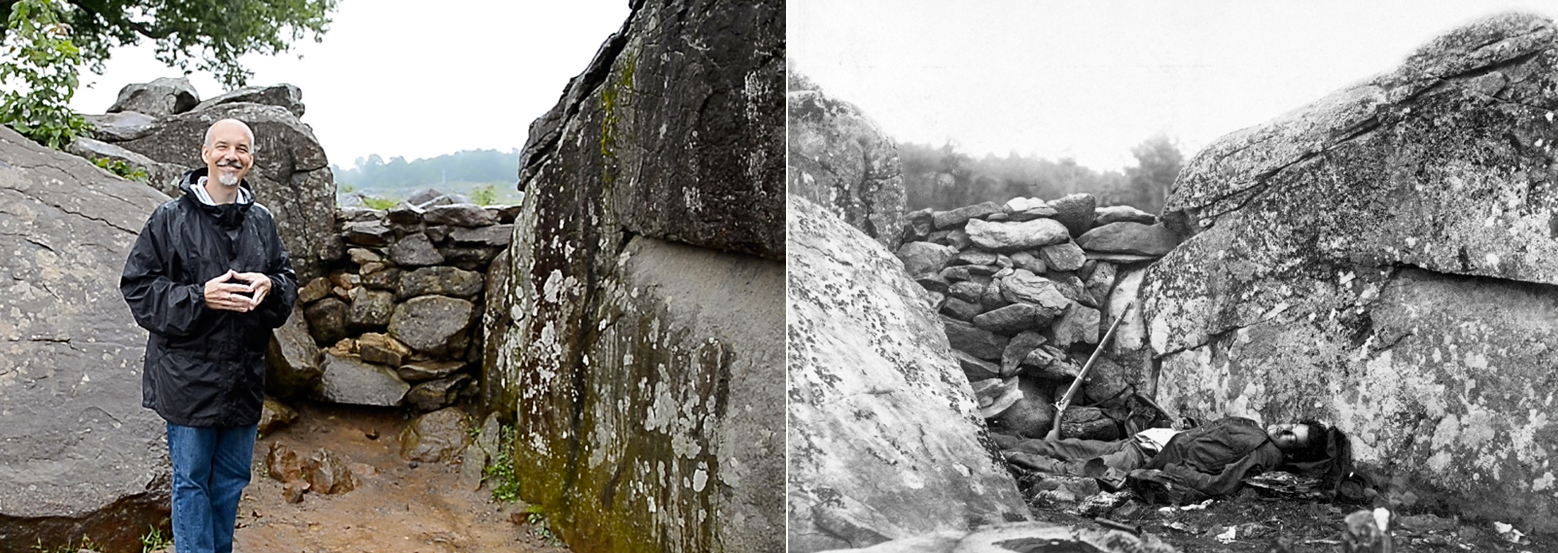Guest Post by Charles W. Mitchell
The Battle of Gettysburg is arguably the most significant ever fought in America. Gettysburg, PA’s hills, rocks, ridges, fences, houses and barns show the topography much as it appeared 150 years ago, in July 1863—though it is less wooded, and all but a few of the thirty-eight orchards of that time have vanished.
In late June of 1863—less than a year after their thrust into Maryland had ended in defeat at Antietam—the Confederate Army of Northern Virginia crossed the Potomac River and marched through Maryland into Pennsylvania to strike at the enemy in his own land. General Robert E. Lee and the Confederate government believed that a triumph on Union soil would hasten negotiations and lead to Confederate independence. There were also tactical and political advantages to this incursion: The invasion would relieve the pressure on Rebel armies in Virginia and the west by drawing Union reinforcements east; and a southern victory could embolden Lincoln’s political opponents, who favored peace talks with the Confederacy. Lee’s army would feast on the bounty of the Maryland and Pennsylvania countrysides, and his men would be positioned to threaten Harrisburg and Baltimore. Terrified Baltimoreans, black and white, slave and free, hastily erected fortifications and barricades.
Thirteen-year-old Maggie Mehring, a student at a private school in New Windsor, Maryland, described the Gettysburg campaign in a series of diary entries from June 19 through July 2, 1863. “It is rumored here that the Rebels have left Frederick and that there is a force of fifty thousand at Getysburg if it is true I hope they will meet a warm reception from Pensylvania in the shape of balls for taking the trouble and liberty of calling on them without an invitation,” she wrote on June 23. After describing the night passage of 5,400 Union soldiers through the town on June 30—“a beautiful sight for the moon shown so brilliantly that one could almost imagine it was day and the horsemen riding six and eight abreast with their sords clatering while cheer after cheer rent the air”—she went on to capture Day Two: “We heard the cannons booming very distinctly last night and it is supposed that there is a battle going on between Littlestown and an[d] Gettysburg.”
Young Maggie may well have heard the fight for Little Round Top, in which “men rushed up the mountainside over their fallen comrades,” wrote a private in the Fourth Alabama Regiment. “Minie balls were falling through the leaves like hail in a thunderstorm.” A Union soldier recalled how his artillerymen’s “hands and faces grew grim and black with burning powder.” A Confederate officer claimed that blood “stood in puddles on the rocks.” With high casualties and low ammunition, and in danger of being overrun, Col. Joshua Lawrence Chamberlain ordered his Twentieth Maine to fix bayonets. Their brazen downhill charge so shocked the Confederates that the Mainers easily routed their right flank. The Rebels, confessed their commander, fled “like a herd of wild cattle.” One spouted blood from a severed windpipe as he ran.
The following day, July 3, Lee attacked what he believed to be a vulnerable Union center, an assault known as Pickett’s Charge, which Union men, ensconced behind a stone wall, repulsed. The armies left a landscape of misery: More than 51,000 dead and wounded—more than ten times the number suffered on D-Day—with thousands of corpses and injured men left to be cared for by Union army detachments, the United States Sanitary and Christian Commissions, and the 2,500 beleaguered townspeople of Gettysburg. Six weeks after the fighting, Marylander Augustus Shriver witnessed “a Boston Lady on the field, who with a stone smashed the teeth out of a rebel skull to take home as relics, and showing as plainly as manners could, that even to the bones of a Rebel she could not show the decency of good breeding.”
Never has there been a better time to visit Gettysburg. A new museum and Visitor Center opened in 2008 with interactive stations, a theater featuring the film “A New Birth of Freedom,” and more battle artifacts, covering the entire Civil War, on display than ever before. Most importantly, the museum’s rich educational mission situates the battle in context by assigning equal emphasis to its origins and consequences.
 Charles W. Mitchell is author of Maryland Voices of the Civil War, which won the 2007-2008 Founder’s Award from the Museum of the Confederacy for outstanding scholarship on the Confederate period. He will discuss his book at the Ivy Book Shop on Tuesday, July 9, 2013, at 7 P.M.
Charles W. Mitchell is author of Maryland Voices of the Civil War, which won the 2007-2008 Founder’s Award from the Museum of the Confederacy for outstanding scholarship on the Confederate period. He will discuss his book at the Ivy Book Shop on Tuesday, July 9, 2013, at 7 P.M.


